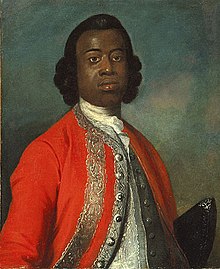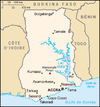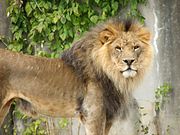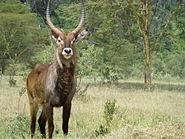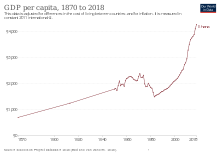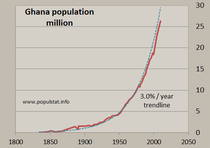Ghana
Ghana, officially the Republic of Ghana (English: Republic of Ghana), is a West African country incorporated as a presidential republic. It is bordered to the north by Burkina Faso, to the east by Togo, to the west by the Ivory Coast and to the south by the Gulf of Guinea. The territory was the object of constant European expeditions, mainly by the Portuguese, British and Dutch, and to a lesser degree of Danes, Swedes and Prussians, for the trade of the large amount of gold that is found throughout the area. For this reason, the territory was called the "Gold Coast".
Currently, the country is one of the most powerful democracies on the continent, highlighting the important role it plays in the most important organization in the area: the African Union (AU). In addition to this, it is a member of other organizations in which the country does not have a leading role: the United Nations (UN), the Commonwealth of Nations (better known by its English name Commonwealth of Nations) and the World Trade Organization (WTO), among others.
With an area of 238,533 km², and a population of 31,486,000 (2022), Ghana is the 82nd largest country and the 46th most populous country,[citation needed ] in addition to having a population density of 132 inhabitants per square kilometer. In recent years, the country has grown demographically and economically, with a Human Development Index (HDI) of 0.632 in 2021 and a product Gross Domestic Product (GDP) of more than $130 billion.
Etymology
It was the Ghanaian politician J. B. Danquah who promoted the present name to the former Gold Coast colony. He gave this name to the territory in honor of the Ghana Empire. In turn, this comes from the Soninké gajanŋa 'king', and was the title given to the kings or tribal chieftains of this medieval empire. It had nothing to do with Ghana, since it was located much further to the northwest, between the present-day republics of Mali and Mauritania, as well as in parts of Senegal and Guinea. It was inhabited mainly by mandinkas.
Ghana was once famous for its gold production, and was indeed named بلاد التبر Bilād al-Tibr (“Land of Gold”) by the Arabs, in the context of trans-Saharan trade. Formerly in Spanish the spelling Gana was recommended for the country.
History
First settlements and origins
Archaeological and linguistic evidence reveals that the area of the current territory was occupied by humans for about 12,000 years, first on the banks of the Oti River, then around 8,000 BC. C., in the lake of Bosumtwi, and then in the plains of Accra, from 4000 a. C. Around the year 1400, most of the states that make up the current country were already founded or were in advanced stages of their formation. In the 16th century many of these territories in the northwest of the Akan forest and in the northeast of the country already had their centralized political authorities.
European exploration and the Gold Coast
The Portuguese arrived in the area around the 15th century. There they found a large amount of gold between the Anakoba and Volta rivers, and for this reason, they baptized this region with the name of Mina. King John II had a castle built in Elmina, in order to be able to exploit and trade gold to the maximum. In 1598, the large amount of this precious metal attracted English, French and Dutch colonists, who tried to seize the gold. territories to the Portuguese. For this, England and the Netherlands built fortresses in the towns of Komenda and Kormantsil from where they tried to expel the Portuguese and French; in this way they managed to gain control of all Ghanaian territory in 1637. The latter baptized the new colony with the name "Gold Coast".
In the 18th century, more European explorers arrived, especially the Spanish, Danish and Swedish, but in little They were eventually driven out, and in the 18th century, William Ansah Sessarakoo was the most successful Ghanaian merchant and businessman in the period 1736–1749. In late 1874, the Dutch withdrew from the area and, as only the British remained,, made the Gold Coast a crown colony. In 1901, the Ashanti and Northern regions became a protectorate.
Nationalism, independence and transformation to republic
Nationalist agitation was suspended during the time of World War II, but resumed in 1945. In fact, the peoples of the Gold Coast supported the British war effort. The Fifth Pan-African Congress held in Manchester in the same year, it served to form on August 4, 1947 an aid for the liberalization of colonial domination.
In 1948, three demobilized soldiers from the colony (Sergeant Frederick Adjetey Cornelius, Corporal Attipoe and Private Odartey Lamptey) were on their way peacefully to Christiansborg Castle to inform the Governor of the difficult situation, but were killed along the way.
On June 12, 1949, Kwame Nkrumah, a politician of the time, formed the first government party in the history of this colony, which stopped cooperating with the British and thus achieved its independence but opposed the Constitution of 1951, Nkrumah was imprisoned along with his collaborators. On February 8, 1951, the first elections in the history of the colony were held, with victory for Nkrumah's party, which was released on February 12 of 1951, and returned to be the leader of the party. Then, due to the strikes that spread through the country, the British governor at the time, the Earl of Listowell, gave them independence on March 6, 1957, Nkrumah became the Prime Minister of Ghana, but there was still a Governor General as representative of the British monarch. On July 1, 1960, the first constitution in its history was drawn up, and from that, it became a republic, by what cute them British rcas ceased to be heads of state.
Republic of Ghana (1961-present)
In 1966, Nkrumah was overthrown in a coup, and thereafter the country entered a period of instability and political change, which ended with a second coup on December 31, 1981 led by the "Air Force Lieutenant Colonels," commanded by Jerry Rawlings.
After coming to power, Rawlings ordered the drafting of a new Constitution in 1992, which incorporated the party system into government.
In 1992, he called elections in which Rawlings emerged victorious until the year 2000, the year in which a victory emerged for the opposition.
In 2009, John Atta Mills took office as President of Ghana with a difference of nearly 40,000 votes (0.46%) between his party, the National Democratic Congress and the New Patriotic Party, this being the second time that power has been transferred from one legitimately elected leader to another, thus acknowledging Ghana's status as a stable democracy. In 2011, John Atta Mills won the NDC congress when he faced Nana Konadu Agyeman Rawlings for the Democratic National Congress. He won by 2,771 votes, representing 96.9% of the total votes cast. On July 24, 2012 John Atta Mills died unexpectedly in Accra. John Dramani Mahama, the vice president, was sworn in in his replacement. Mahama won the election on December 7, 2012, and took office again in January 2013.
Government and politics
Ghana is a republic with a presidential system, characterized by being one of the most robust democracies in sub-Saharan Africa.[citation needed] The current constitution came into force on January 7, 1993, although the first constitution in the country's history was promulgated in 1960. This constitution guarantees, among other things, universal suffrage. Although Ghana follows multiparty politics, since the restoration of democracy in 1992 electoral competition has been deeply bipartisan, with the center-right New Patriotic Party (NPP) and the center-left National Democratic Congress (NDC) as the country's main political parties.. In the 2016 general election, the NPP and NDC won all the seats in Parliament for the first time, so there have been no executive or legislative positions held by any other party since then. Their traditional (pre-colonial) chiefs still have space politician in the National Chamber of Chiefs, recognized in the constitution.
Foreign Relations
Foreign relations is primarily concerned with the security of the 3 million Ghanaians living outside the country. It is a member of major international organizations such as the United Nations, the World Trade Organization, the African Union (an organization in which it has an important role) or the Commonwealth of Nations. In addition, it is the largest provider of peace in sub-Saharan Africa, and has sent around 2,995 blue helmets to the United Nations, and 900 soldiers by force interim office in Lebanon of that organization. At the end of 2012, he had a dispute with the Argentine Republic due to the illegal retention of the warship A.R.A. Freedom in the port of Tema at the request of American speculative funds.

Currently, it is maintaining relations with the European Union (EU), especially for a negotiation of new bilateral agreements between both territories. It should be noted that among these agreements is the export of wood and its agricultural products, and the agreements visa. For this reason, it maintains embassies in the main towns of the association, including Berlin, London, Madrid, Paris, Rome, Moscow and Ankara.
Like the EU, the United States also has relations with this country, having an embassy in the capital, and vice versa. They have been good not on an official level, but on a personal level since their independence. They have close agreements between educational and scientific institutions, and great cultural ties. In addition, it is one of the main commercial partners, where many American multinational companies operate, especially Coca Cola, FedEx, Motorola, Delta Air Lines, United Airlines, Cargill, Ups, Price Waterhouse, General Electric and NCR Corporation, NCR Corporation ICT and Cash Register specializing in solutions for the retail and financial industry.
Armed Forces
In 2009, the government spent approximately 1.7% of its GDP on its armed forces, making it the 87th country that spends the most on its military. They are divided into three components: the Army, the Navy and Air Force. Its equipment is basically made up of machines manufactured abroad, mainly from the United Kingdom, Brazil, Sweden, Switzerland, Israel and Finland. In addition, it maintains close ties with the People's Liberation Army. Between 18 and 26 years of age you can take a voluntary course in the army, which does not imply admission to it.
In 1994 it had a staff of about 6,850 people, distributed in 850 for the navy, 5,000 for the army, and the remaining 1,000 are specialized in the air force. In addition, it has an internal security force in which 16,000 policemen work, 5,000 members of the people's militia, and a national civil defense force made up of all able-bodied citizens. The air force has a fleet of 35 aircraft and in the coming years it will rise to 37, due to the purchase of 2 units of Airbus Military C-295.
Human rights
In terms of human rights, regarding membership of the seven bodies of the International Bill of Human Rights, which include the Human Rights Committee (HRC), Ghana has signed or ratified:
Territorial organization
The territory is divided into 16 administrative regions, which in turn are divided into 138 districts and these into 16,000 committees. The administrative regions have names from the Colonial Era, and these regions are: Greater Accra, Western Ghana, Eastern Ghana, Central Ghana, Ashanti, Volta, Brong-Ahafo, Northern Ghana, Eastern Upper Ghana and Western Upper Ghana. They do not have gubernatorial elections, as they are appointed by the nation's president.
Each district has a District Assembly made up of elected and appointed members. 70% of the members are elected by the population, and the remaining 30% are appointed by the president. Of the seats reserved for appointees, 50% are allocated to women. Despite this, women represent only a small proportion of the members of the District Assembly, which is less than 10%.
Geography
Topography
Ghana is located in West Africa. It borders Burkina Faso to the north, Togo to the east, the Ivory Coast to the west, and the Gulf of Guinea to the south. It is also one of the countries through which the Greenwich Meridian crosses in the east.
With an area of 238,533 km², it is the 82nd largest country in the world. Approximately half of the country is less than 150 meters above sea level. There are only slight elevations in the western part, where the Ashanti Plateau is located, which separates the plain in the northwest from the coastal plain. /p>
Ecology
Lake Volta is the 23rd largest in the world but it also forms the largest reservoir in the world with an area of 8,502 km². For this purpose, the Akosombo dam was built in the southern part of the lake where the two rivers: the White Volta and the Black Volta, which from there form a single river. This construction has had major environmental problems, although it generates much of the energy for Togo and Benin.
Flora and fauna
Ghana has a great diversity in terms of flora and fauna. The most typical animals that can be found are leopards, elephants, antelopes, buffaloes, lions, and birds and butterflies typical of the tropical climate. As for plants, you can mainly find mangroves and palm trees.
Climate
In most of the country it is a tropical climate, either humid or dry, depending on the time of year, also, the temperature varies by season and elevation. Generally, the lowest are in August and the highest are in March. Between December and March, the harmattan blows a dry wind of desert origin from the northeast, which means a reduction in humidity and hot days and cold nights to the north; this wind, too, can be felt in January in the south of the country.
The main climatic factor is rain. This season corresponds to the summer months in Europe, from April to September, reaching its maximum in June and July.
| Month | Ene. | Feb. | Mar. | Open up. | May. | Jun. | Jul. | Ago. | Sep. | Oct. | Nov. | Dec. | Annual |
|---|---|---|---|---|---|---|---|---|---|---|---|---|---|
| Average temperature (°C) | 32 | 32 | 32 | 32 | 31 | 29 | 27 | 27 | 29 | 30 | 31 | 31 | 30.3 |
| Temp. medium (°C) | 23 | 23 | 24 | 24 | 23 | 23 | 22 | 21 | 22 | 22 | 23 | 23 | 22.8 |
| Total precipitation (mm) | 16 | 37 | 73 | 82 | 145 | 193 | 49 | 16 | 40 | 80 | 38 | 18 | 787 |
| Hours of sun | 207 | 219 | 216 | 213 | 204 | 144 | 138 | 150 | 171 | 213 | 240 | 228 | 2343 |
| Relative humidity (%) | 79 | 77 | 77 | 80 | 82 | 85 | 85 | 83 | 82 | 83 | 80 | 79 | 81 |
| [chuckles]required] | |||||||||||||
Economy
Key sectors
Ghana is a country fairly rich in natural resources with industrial minerals, hydrocarbons and precious metals. After the constant fall in the real value of the Cedi, in 2014 inflation increased rapidly, and the value of the third Cedi fell to a quarter of its originally printed value. This fall in value was contained in the last quarter of 2014 when this currency stabilized after the request for a negotiated cessation of payments (a supposed bailout) and after the renegotiation of the debt of the Government of Ghana to the IMF. The perception of corruption in the last five years in Ghana has worsened, which has been accompanied by a decline in its position in the international corruption ranking, which slows down investment. According to 2014 data in Ghana, the richest 10% of the population consumes almost a third of the resources, the same amount consumed by the poorest 60%. By contrast, the poorest 10% only access 2% of the resources.
As a result of liberalization and privatization, corruption has spread especially in the judiciary described as the most corrupt on the continent. Ghana is one of the 50 most unequal countries in the world and, as Oxfam points out in its latest reports, in In this country “inequality is on the rise, undermining poverty reduction, holding back economic growth and threatening social stability. In Ghana the richest 10% of the population consume almost a third of the resources 32%, the same amount consumed by the poorest 60%. On the contrary, the poorest 10% only access 1.2% of the resources By the year 2020, Ghana is the second largest economy in West Africa after Nigeria. The agricultural sector remains crucial, accounting for around 30% of GDP and 50% of employment. The volume of traditional exports (cocoa, gold and other natural resources) continues to be important within the economy. Currently the country's economy is largely dependent on trade with China. The agriculture sector is the largest source of income for the majority of Ghanaians constituting 60%. Investment in agriculture has fallen dramatically in the last decade and represents only 6.2% of government investment. It has an economic plan called “Ghana Vision 2012”. This plan casts Ghana as the first African country to become a developed country between 2020 and 2029 and a new industrialized country between 2030 and 2039. This excludes the member of the Group of 24 and South Africa, which is a new country. industrialized. Ghana's economy also has links to the Chinese renminbi yuan along with Ghana's vast gold reserve. In 2013, the Bank of Ghana began circulating renminvi through Ghanaian state banks and to the Ghanaian public as a hard currency alongside the Ghana cedi for a second currency market. In recent years inflation, which has grown progressively since 2009 and is currently at 9.08%, and average income. All these values make the country rank 114 out of 168 in the Index of Global Competitiveness.
The state owns the Volta River Authority and the Ghana National Petroleum Corporation which are the two largest producers of electricity. The Akosombo Dam, built on the Volta River in 1965, along with the Bui Dam, Kpong Dam, and other hydroelectric dams, provide hydroelectric power.
Economic growth

According to the revisions made by the government in 2011, the deficit was 4.3% of its GDP, 0.2% more than in 2010, so it had a negative balance of payments. In 2010, the government faced a debt of 1,438 million dollars, which is why it ranks 144th in the ascending list of indebted countries.
On January 1, 1995, Ghana gained entry into the World Trade Organization (WTO) thanks to its rich agriculture. The main crops are maize, bananas, rice, millet, sorghum, cassava and yams. Unlike livestock, this sector is key to the country's economy, a trait shared by the majority of states that present an economy with irregular growth.
Mineral Resources
Mining is also gaining importance in the country, with growth of around 30% in 2007; the main extractions are bauxite, gold (the country is the second largest African producer after South Africa) and the phosphates. The Ghana Stock Exchange is the third largest and best in the entire African continent (after the first, the South African Johannesburg Stock Exchange and the second, the Nigerian Stock Exchange).
Industry
The industry is also very diverse, but the most important are food, manufacturing, tobacco, clothing, lumber, chemical and pharmaceutical products, metal, and beverages In 2004, the government activated a project called Waste Stock Management and Exchange System, whose objective was the treatment of industrial waste, in order to protect coastal and water ecosystems sweet.
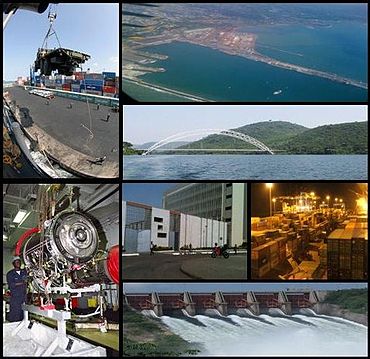
Trade, Entrepot trade, Financial Services, Electronics,
University Education, Mining, Wood Industry, Tourism,
Light Industry, Aluminium Founding, Cemento Industry,
the Naval Construction, the Food Processing, ICTs,
the Telecommunications and Electrical Energy Generation Industry.
Tourism
Tourism contributed 4.9% of GDP in 2009, attracting around 500,000 tourists thanks to its two places recognized as World Heritage Sites: the traditional buildings of the Ashanti, and the castles and forts of Lake Volta.
To enter the country it is necessary to have a visa authorized by the government, except for certain businessmen who are on a business trip. These visas can be obtained at the embassy in each country. Visas are paid, except for foreigners. Nationals of some Commonwealth countries in East and South-East Africa who can get free visas at the country's borders; these countries are: Botswana, Lesotho, Malawi, Swaziland and Tanzania.

Fort Amsterdam, was built as Fuerte Cormantine in Central Ghana. Fuerte Metal Cross, was built in Western Ghana as a commercial post in 1683.
Fort Groot Fredericksburg in West Ghana and Kakum National Park. From below and from left to right: Anomabu Beach in Central Ghana, Ezile Bay Beach in West Ghana, Elmina Beach in Central Ghana,
Ada Foah Beach in Gran Acra, Busua Beach in West Ghana and Labadi Beach in Gran Acra.
Infrastructure
Energy
In 2010 the government created an energy policy for the realization of new projects, in order to improve the rapid growth of energy needs that have been emerging, the greater use of renewable energy and waste treatment. Electricity is one of the key factors in achieving the development of the national economy, with a consumption of 265 kilowatts in 2009.
In addition, thanks to the Akosombo Dam, it also produces a large amount of hydroelectric power, some of which is transported to Togo and Benin. Other forms of energy that produce electricity in this country are solar, wind, and biomass.
Ghana has been producing oil since December 15, 2010, and as of mid-2011 it was producing around 70,000 barrels per day and is expected to rise to 80,000 barrels. There are also large reserves of natural gas, which is used by many foreign multinational companies. In addition, the government opted for nuclear energy, since according to it, hydroelectric and thermal power plants are insufficient to meet the demand of this sector. Therefore, it will have a nuclear plant by the year 2018.
Transportation
The country has a road network of 62,221 km, of which only 9,955 km are paved. The railway network occupies an area of 947 km, and these are only national, that is, they do not go to the neighboring countries, but there are plans to extend some lines to Burkina Faso.
It also has a total of 11 airports, of which the most important is the Kotoka International Airport located in Accra, with a transit of 1'204,786 passengers in 2009. After the cessation of operations of Ghana International Airlines, the main airlines are Antrak Air, CTK-CiTylinK and Staebow Airlines with which you can fly to national destinations and the main points of the African continent.
In addition, many of the world's largest international airlines also serve many of the world's largest international airlines, so Ghana can fly to major points in the United States, Europe and the Middle East.
There are Bus Rapid Transit, Rail, and Taxi services connecting large cities with each other, and minibuses, called Ttrotros, connect large cities with rural areas and small towns., there is a network of passenger ferries that are responsible for crossing Lake Volta.
Media
As of 2011 statistics, there are 284&nbs;700 telephone lines and 21,166,000 cell lines, making it the 119th and 46th with the most telephone lines, respectively. Your call prefix international number 233, while its Internet code is.gh. There are also a large number of Internet users, specifically about 1.3 million, being the 93rd with the most users, coinciding with the number of servers website, with 41,082.
The Republic of Ghana has the 3rd fastest Internet connection speed in the entire African Continent.
The press is another medium with a large following, although it only has four daily newspapers, which are: Business and Financial Times, Ghana Review International, The Heritage and The Ghanaian Chronicle. In addition, it has five television and radio networks, which are: Cn Joy, Peace, Joy 997, Ghana Waves and Telediaspora.
Demographics
In 2010, the national census estimated a population of 24,658,823 inhabitants and a density of 103 inhabitants per square kilometer. the United Nations Development Program. In 2006, 27% of the population lived below the International Poverty Line, set at $1.25 per day in 2011. The population consists of 36, 5% of children between 0 and 14 years of age, 60% of people between 15 and 64 years of age, and 3.5% of people over 65 years of age, and 51.2% (12,633,978) of the population of the Ghana is female and 48.8% (12,024,845) of Ghana's population is male.
Ethnography
There is a great variety of ethnic groups, among which the Akan (45.3%), the Mole Dagbon (15.2%), the Ewé (11.7%) and the Ga Dangme (7, 3%), among others. Ethnic conflicts are rare, and there is a greater feeling of national unity than in most African countries.
Each ethnic group maintains its own traditions, as is the case with the Akan. The most important ethnic group in the southern part of the country is the Akan, while in the east the Ewé are the most numerous group.
The official language, and in turn the most used, is English. However, there are many ethnic languages that have regional relevance such as Asante (Akanic), spoken by 14.8%, Ewé by 12.7% and Fante by 9.9%. The remaining 34% of the population speak other languages such as Boron, Dagomba, Dangme, Dagaba, Akyem, Ga and Akuaoem.
Religion
According to the 2010 census, 71.2% of the population practiced Christianity (charismatics 28.3%, Protestants 18.4%, Catholics 13.1% and other Christian cults 11.4%). This religion was brought by the Portuguese in the year 1466.
Islam, practiced by 17.6% of the population, in the 2010 census, arrived in the territory in the year 1076.
Another 5.2% said they practice traditional cults and 0.8% did not specify their religion, in the 2010 census.
Health
According to 2009 statistics, life expectancy at birth was 64 years, and the probability of dying before the age of 5 per 1,000 live births was 45. Health spending per inhabitant was $122., being in the government 8.1% of its GDP. In 2008, the smoking rate for people over 15 years of age was 9.5% for men and 0.7% for women, being the rate of obesity in 2006 for people also over 15 years of age, in men of 4.4% and in women of 11.7%.
In 2011, the birth rate was 28 births per 1,000 people, while the death rate was 8.57 deaths per 1,000 people, which makes for positive population growth.
Because the health infrastructure is not yet highly developed, vaccination against yellow fever is essential, and updating the official vaccination schedule is recommended. In addition, there is also a risk of malaria throughout the country. The disease of AIDS, has been significantly reduced; currently, there are only 225,400 people with this disease.
Healthcare in the Republic of Ghana is covered by the Ghanaian Universal Healthcare Service or Ghana National Health System or (NHIS) which assumes fiscal and administrative responsibility for Healthcare.
Education
There are 4 stages of education in Ghana: preschool, primary, secondary and tertiary. Preschool is not compulsory, it is dedicated to children between the ages of 3 and 6. Then comes primary which It is oriented for children from 6 years old and is compulsory, in addition to lasting six years. Then comes secondary school, which lasts 3 years in junior high school and another 3 in upper secondary school; For this stage, a study plan has been designed for the choice of a series of subjects; is compulsory. At the end of this stage, the student must be in national service for one year. Finally, tertiary or higher education arrives, which consists of 4 years of education at the university, polytechnic schools, or other educational institutes professional; this level is being refurbished.
Ghana has ventured into virtual education with a revolutionary project to include women using virtual classes. [citation needed]At the moment, virtual classes are being given to more than 8000 students in total, in different sectors of Volta and Accra, especially in the remote villages where the Girls are at higher risk of dropping out of school.

Main locations
Languages
Ethnologue lists a total of 79 languages in Ghana. English is the official language of the country and predominates in government and business, it is also used as the usual language for education.
The indigenous languages of Ghana are divided into six subfamilies, all belonging to the Niger-Congo languages. The Kwa languages are the main subfamily and account for 70% of the country's population; this group includes the Akanic and the Ga-dangme languages. These languages are mainly spoken in the southern half of the country along the Volta River. The Gbe languages, whose inclusion within the Kwa group is disputed, include Ewe, spoken in the southeastern Volta. The gur subfamily includes the dagbani, dagaare, and frafra, and they are found predominantly in the north. Two Kulango languages (previously misclassified as Gur languages) are spoken in the central area of the western frontier. The Senufo, in the north, include the nafaanra. In addition, two Mandé languages are spoken, Bissa in the northeast corner and Ligbi spoken near Kulango.
Nine languages are officially recognized: Akan, Ewe, Dagomba (Dagbane), Adangme, Dagaare, Ga, Gonja, Kasem, and Nzema. Although not officially recognized, Hausa is the lingua franca among Ghanaian Muslims.
Since 2007, all university institutions in Ghana have taught Chinese courses. This initiative reflects the growing influence of the People's Republic of China as a superpower and the country's close relations with China. In addition, Ghana is a member of the OIF, and French has a strong presence in secondary education.
Culture
| Date (2011) | Name in Spanish |
|---|---|
| 1 January | New Year |
| 6 March | Independence Day |
| 22 April | Good Friday |
| 25 April | Easter Monday |
| 2 May | Labour Day |
| 25 May | Day of Africa |
| 1 July | Day of the Republic |
| 31 August | End of Ramadan |
| 21 September | Foundation Day |
| 7 November | Feast of the Lamb |
| 2 December | Farmers' Day |
| 25 December | Christmas |
| 27 December | Family Day |
Gastronomy
Ghana has one of the most varied cuisines in the west of the continent. The main ingredients in the kitchen are spices and vegetables, especially cayenne, pepper, ginger, garlic, onion and chili. In addition, there is a great diversity of typical dishes, highlighting fish stews, Kenkey (steamed corn dumpling) and Fufu (small plant roots served with starch grains).
Literature
The national literature is one of the oldest on the entire African continent, since the first Ghanaian literary work dates from the year 163 AD. C.
The most prominent Ghanaian authors are novelists such as J. E. Casely-Hayford, Ayi Kwei Armah or Amu Djoleto, who achieved international success thanks to their most famous works, which are "The beautiful have not yet been born" and "Hurricane de Polvo", respectively. In addition to the novel, other arts such as theater and poetry have also had a good development at the national level.
Architecture
There are two types of traditional construction in the country. The traditional round grass-roofed huts and the series of adjacent buildings in an enclosure surrounding a common area. The former are found in the northern regions, while the latter are found in the south.
Regarding urban architecture, it has had a lot of social and cultural influence, giving a more heterogeneous environment than the architecture of rural areas.
Music and dance
The most popular music is hiplife, although there are other genres of music such as highlife, palm-wine, yo-pop and apala, influenced by Muslim culture.
It has a wide variety of musical groups, such as Adesa, Flexy, Nipa, R2Bees, Rocky Dawuni or Veeda. It is also worth noting that in 1950 Kofi Ghanaba brought drums to the west of the country.
Ghanaian dances are synchronized with traditional music, being used in celebrations of various kinds, such as the Azonto, the Kpanlogo, the Adowa, the Klama and the Bamaya.
Sports
Soccer is the most popular sport in the country. The category that has most triumphed in this sport has been the under-17 and under-20 youth, who have won gold, silver and bronze medals in international championships. There are several soccer leagues: national and regional. As for senior football, the greatest achievement was reaching the quarterfinals of the 2010 World Cup, being left out by Uruguay.
The base of its senior soccer team is made up of practically players who play in soccer leagues abroad, mainly European soccer. Although it also has one of the most important leagues on the continent, with African champion teams such as Hearts of Oak from Accra or Asante Kotoko from Kumasi, named the best African team of the 20th century.
There are many outstanding Ghanaian athletes, the country's most outstanding athlete is Abédi Pelé, who is part of the FIFA 100, a list of the 125 greatest living footballers in history.
Contenido relacionado
Iberian Peninsula
The Wolf (1941 film)
Castile and Leon

